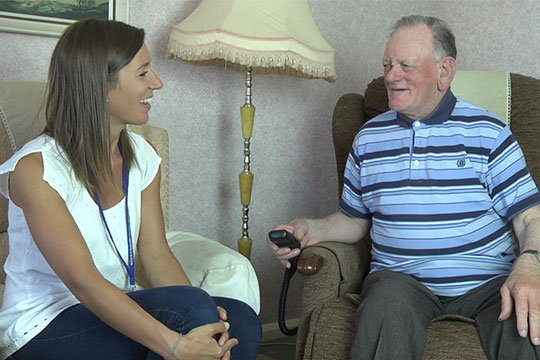 It is important to stay safe at home. Some conditions such as epilepsy or dementia can affect your safety.
It is important to stay safe at home. Some conditions such as epilepsy or dementia can affect your safety.
10 things that could help you to take care of someone in the home
Trip hazards: Be aware of rugs, loose cables, items on the stairs or low tables.
Soft furnishings: Cushions, rugs, carpets, heavy curtains, tablecloths will help absorb noise.
Layout: Don’t make major changes in the home environment for example moving furniture, unless really needed and ask someone for help if you need to.
Make it personal: Rooms should reflect their use and be individualised, use photos and objects that are interesting to the person.
Noise: Reduce background noise to support the person to engage in daily activities.
Flooring: Try not to use patterned or shiny flooring. Keep it plain.
Lighting: Use natural light by day and soft-coloured lighting at night time.
Visual cues: Use pictures to help with finding their way round, for example, ‘bathroom’ and ‘kitchen’.
Contrasting: Use bright and contrasting colours but avoid patterns to reduce confusion and distraction.
Here are some websites you may find helpful:
Supporting someone with dementia
If you are caring for someone with dementia here are some tips:
- Don’t assume: Don’t over or under estimate the person’s ability, it changes day to day.
- Offer encouragement: Offer encouragement and give the person time to process the request and repeat if required.
- Coping with distress: Sometimes a person believes something which may not be true. Do not dismiss this as untrue but get them to talk about it. Remain calm and redirect the conversation.
- Visual cues: Support understanding with pictures.
- Noise: Try to reduce any background noise.
- Activities: Use reminiscence (remembering) activities to relive good memories. This could be through sounds, smells, taste or pictures.
- “Use it or lose it”: Encourage everyday activities even if they can only complete a little bit of the task. Stick to your everyday routine as much as you can.
- Memories: Create memory boxes or/and life story books, make sure the person is involved as much as possible.
- Contrasting: Use bright and contrasting colours but avoid patterns to reduce confusion and distraction.
Here are some websites you may find helpful:

